Last updated on 6 April 2025
Please note if you are using DSM7.2 or higher you should use the Container Manager version of this guide from the menu.
This guide has reached the end of its updates as most people are now on the latest DSM update - This guide is correct as of 08/12/2023 however no further updates will be added.
Important or Recent Updates
| Historic Updates | Date |
|---|---|
| New guide published | 28/07/2022 |
| AnalogJ has been busy notification settings updated | 05/08/2022 |
| Small tweak to the collector.yaml section and also the compose file to ensure NVME cache drives are shown correctly | 18/08/2022 |
| Added an extra section on how to secure the InfluxDB via environment variables | 19/01/2023 |
| Compose version number removed and small wording amendments | 09/04/2023 |
| Amended the path to save the compose file – this is for security, so the container has no access to the file contents. | 14/04/2023 |
| Amended SSH section to line up with the latest version of the guide in the 7.2 section | 16/10/2023 |
What is Scrutiny?
Scrutiny is a Hard Drive Health Dashboard & Monitoring solution, merging manufacturer provided S.M.A.R.T metrics with real-world failure rates.
Let’s Begin
In this guide I will take you through the steps to get Scrutiny up and running in Docker.
In order for you to successfully use this guide please set up your Docker Bridge Network first.
Scrutiny currently cannot be setup via the DSM Docker UI, so we will be using Docker Compose to get things up and running, this is not as complicated as it seems.
Getting our drive details
We need to get some details about our drives in order for Scrutiny to read their SMART data.
It’s time to get logged into your Diskstation via SSH, in this guide I am using Windows Terminal however the steps will be similar on Mac and Linux,
Head into the DSM Control Panel > Terminal & SNMP and then enable SSH service.
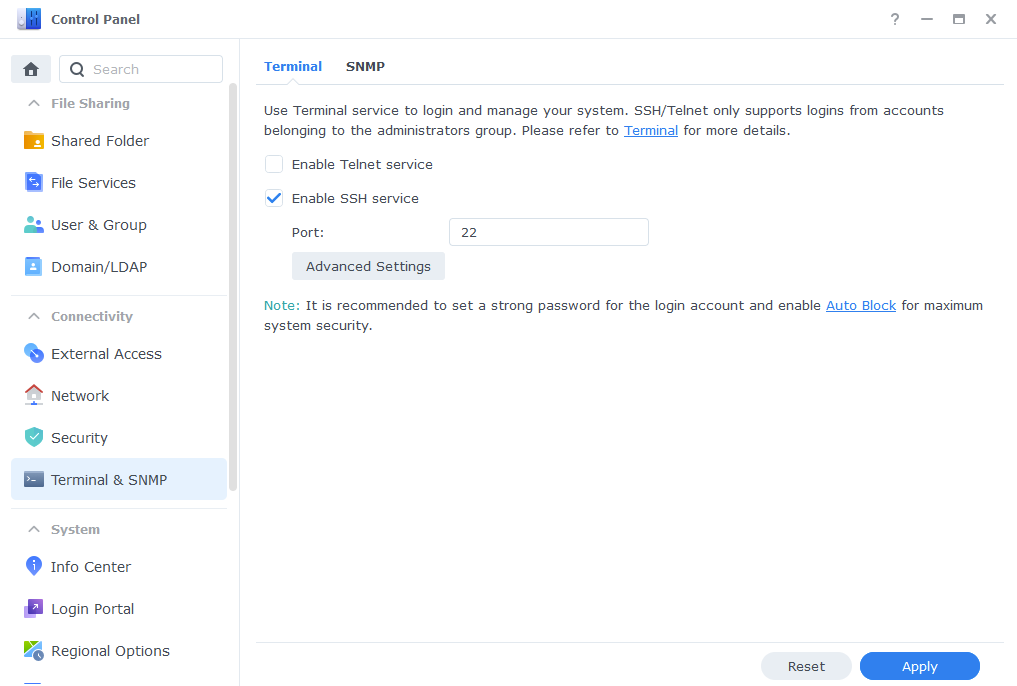
Open up ‘‘Terminal’

Now type ‘ssh’ then your main admin account username @ your NAS IP Address and hit Enter
ssh drfrankenstein@192.168.0.101
You will then be asked to enter the password for the user you used you can either type this or right click in the window to paste (you won’t see it paste the info) then press enter.
Enter the login information for your main Synology user account, you will not be able to see the password as you type it. (If you are using a password manager right-clicking in the window will paste – you won’t be able to see it)
Now we are logged in we just need to do a single command to see our drives, note I am not prefacing this command with sudo as we don’t need the low level detail. You will see permission denied errors, but these can be ignored.
fdisk -lThe output you will see depends on the model NAS you own, the two examples below are from an 1821+ and an 1815+ which have 8 bays and the 1821+ has up to 2 NVMEs.
The 1815+ has 8 drives broken down from sda to sdh
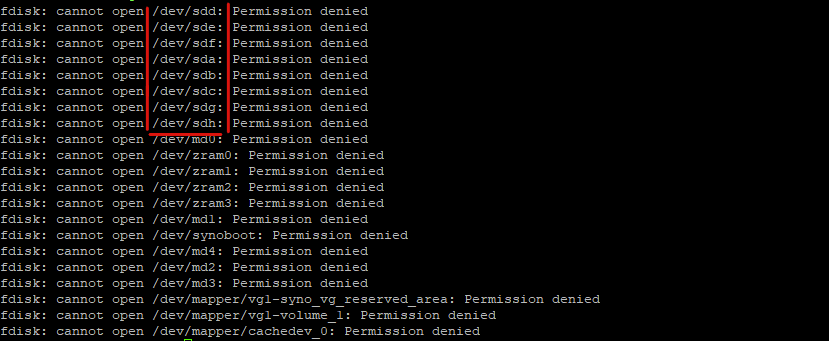
The 1821+ has 8 drives broken down into SATA and NVME devices, sata1 to sata8 with the single nvme0n1.
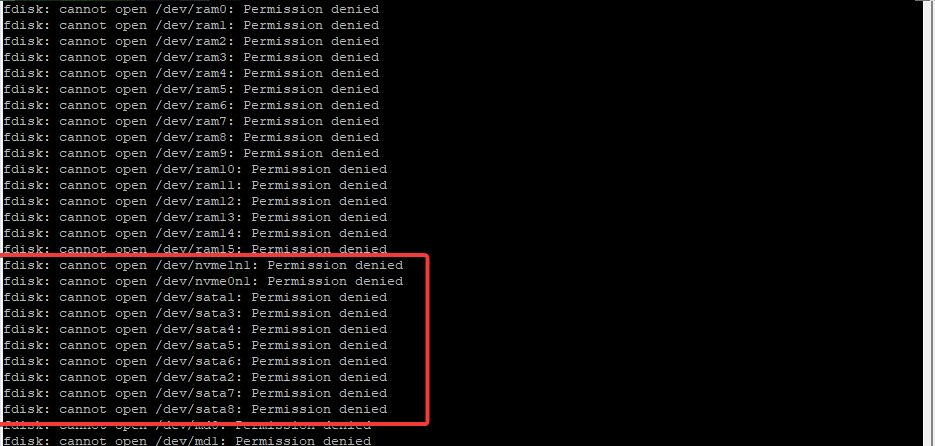
Make note of the devices you see in your output as we will need them for the config file and compose.
Config Files and Folders
Next let’s create the folders the container will need. Head into FileStation and create a subfolder in the ‘docker’ share called ‘scrutiny’ and then within that another called ‘influxdb’ it should look like the below.

Next comes the config files, you can edit this file in a number of ways, but to keep the guide OS-agnostic we will be using the Synology Text Editor package which can be installed via Package Center.
Open up a new text document and paste one of the two code snippets below into it. Use the one that matches up with the way your drives are shown in the previous step (if you come across anything different let me know in the comments!)
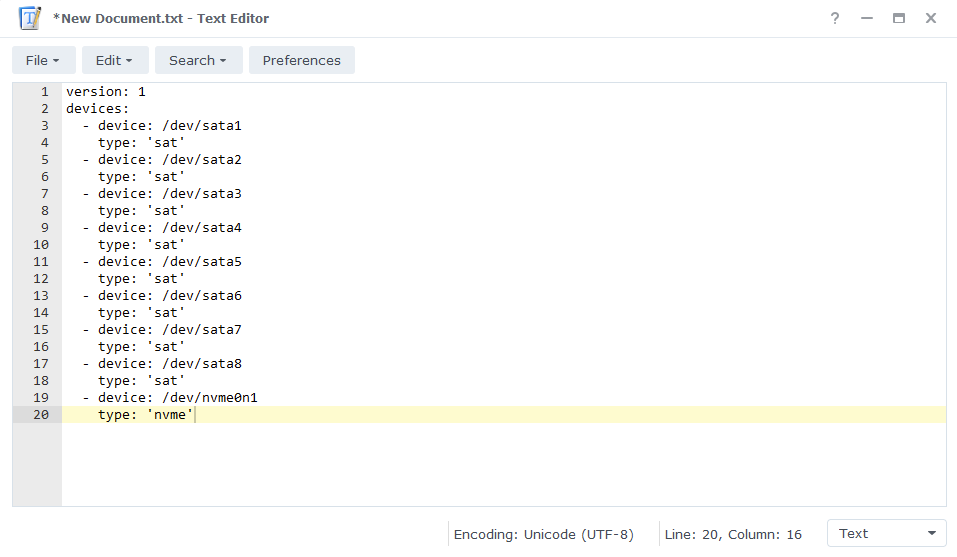
Type 1
version: 1
host:
id: ""
devices:
- device: /dev/sata1
type: 'sat'
- device: /dev/sata2
type: 'sat'
- device: /dev/sata3
type: 'sat'
- device: /dev/sata4
type: 'sat'
- device: /dev/sata5
type: 'sat'
- device: /dev/sata6
type: 'sat'
- device: /dev/sata7
type: 'sat'
- device: /dev/sata8
type: 'sat'
- device: /dev/nvme0n1
type: 'nvme'
- device: /dev/nvme1n1
type: 'nvme'Type 2
version: 1
host:
id: ""
devices:
- device: /dev/sda
type: 'sat'
- device: /dev/sdb
type: 'sat'
- device: /dev/sdc
type: 'sat'
- device: /dev/sdd
type: 'sat'
- device: /dev/sde
type: 'sat'
- device: /dev/sdf
type: 'sat'
- device: /dev/sdg
type: 'sat'
- device: /dev/sdh
type: 'sat'You will need to edit the config file in line with the number of drives you had in the output earlier either adding or removing lines accordingly, including adding or removing the NVME drives.
Next you can save this file as ‘collector.yaml’ in the ‘/docker/scrutiny’ folder.
Notifications Config (optional)
This step is optional and depends on if you want to set up some notifications in case one of your drive has issues.
As of writing there are 14 different notification method, as you can imagine I cannot cover every single type in this guide, but this will get the config file in place for you to amend based on your preferences
Open up a new file Text Editor again, this time you need to copy and paste the full contents of the example config file located here
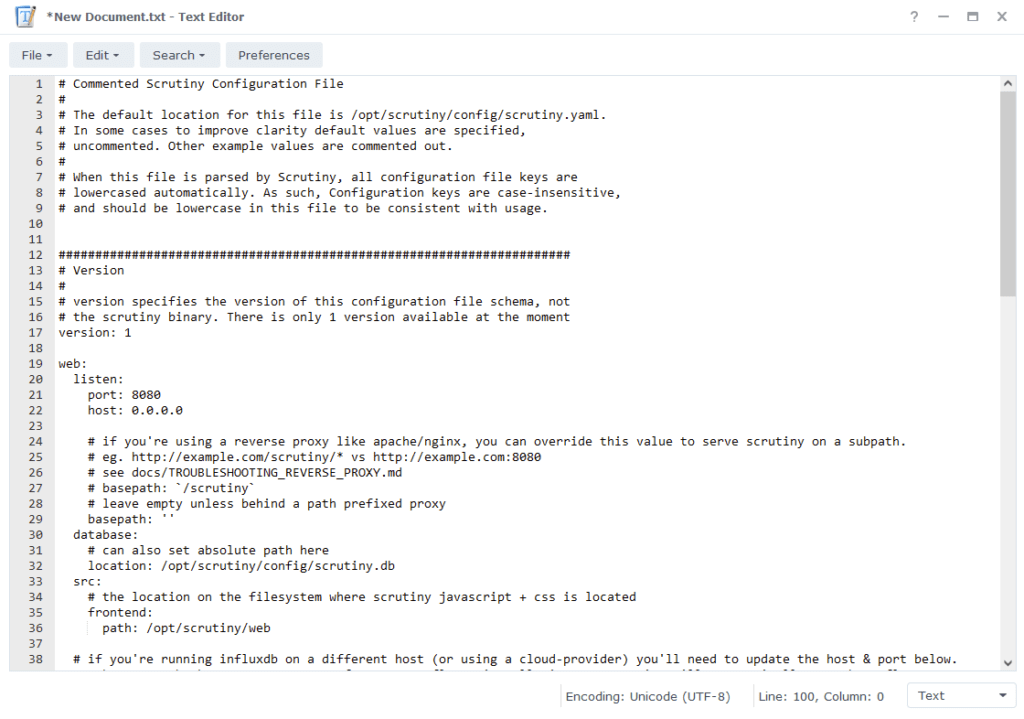
Scroll to the bottom of the file where you will see a number of config options for notifications. You will need to the remove the # from the ‘notify’ and ‘urls’ lines and then depending on which type of notification you decide to set up the # will need to be removed from the corresponding line.
The level of notification you receive (Critical or All Issues) can be set up in the WebUI once Scrutiny is up and running.

Finally, save this file as ‘scrutiny.yaml’ into the /docker/scrutiny folder.
Docker Compose File
We will be using Docker Compose to set up the container. In a nutshell we will be creating a text file (YAML formatted) which tells Docker exactly how we want it set up.
Open up a new file in Text Editor again and copy the code below into it.
services:
scrutiny:
container_name: scrutiny
image: ghcr.io/analogj/scrutiny:master-omnibus
cap_add:
- SYS_RAWIO
- SYS_ADMIN
ports:
- "6090:8080" # webapp
- "8086:8086" # influxDB admin
volumes:
- /run/udev:/run/udev:ro
- /volume1/docker/scrutiny:/opt/scrutiny/config
- /volume1/docker/scrutiny/influxdb:/opt/scrutiny/influxdb
devices:
- /dev/nvme0n1:/dev/nvme0n1
- /dev/nvme1n1:/dev/nvme1n1
- /dev/sata1:/dev/sata1
- /dev/sata2:/dev/sata2
- /dev/sata3:/dev/sata3
- /dev/sata4:/dev/sata4
- /dev/sata5:/dev/sata5
- /dev/sata6:/dev/sata6
- /dev/sata7:/dev/sata7
- /dev/sata8:/dev/sata8
environment:
- SCRUTINY_WEB_INFLUXDB_TOKEN=ANYLONGSTRING
- SCRUTINY_WEB_INFLUXDB_INIT_USERNAME=A-USERNAME
- SCRUTINY_WEB_INFLUXDB_INIT_PASSWORD=A-PASSWORD
network_mode: synobridge
restart: unless-stoppedAs you can see the devices section contains all our drives, you will need to amend this again in line with the config file you created earlier. You will need to amend the paths each side of the : so they match, adding or removing drives accordingly including the NVMEs.
e.g., /dev/sata1:/dev/sata1 or /dev/sda:/dev/sda and so on.
In addition to this you will see in the ‘environment’ section three variables that will need to be updated as outlined below, these secure the database used by scrutiny.
| Variable | Value |
|---|---|
| SCRUTINY_WEB_INFLUXDB_TOKEN | enter a sting of characters you can use almost anything treat it like a password so a nice long string |
| SCRUTINY_WEB_INFLUXDB_INIT_USERNAME | This can be anything you like |
| SCRUTINY_WEB_INFLUXDB_INIT_PASSWORD | a secure password |
These 3 values are only required for the first ever setup – you can remove them once Scrutiny is up and running.

Once you have made the edits save this file as ‘scrutiny.yml’ in ‘/docker’
SSH and Docker-Compose
We are now on the final section, you can now log back into your NAS via SSH again.

Once you have logged in you will need to give 2 commands, you can copy and paste these one at a time — you will need to enter your password for the command starting with ‘sudo’
First we are going to change directory to where the scrutiny.yml is located, type the below and then press enter.
cd /volume1/dockerThen we are going to instruct Docker Compose to read the file we created and complete the set-up of the container. Again type or copy the below and press enter.
sudo docker-compose -f scrutiny.yml up -dWhen the command has completed you should be able to see Scrutiny running in the list of containers in the Synology GUI.
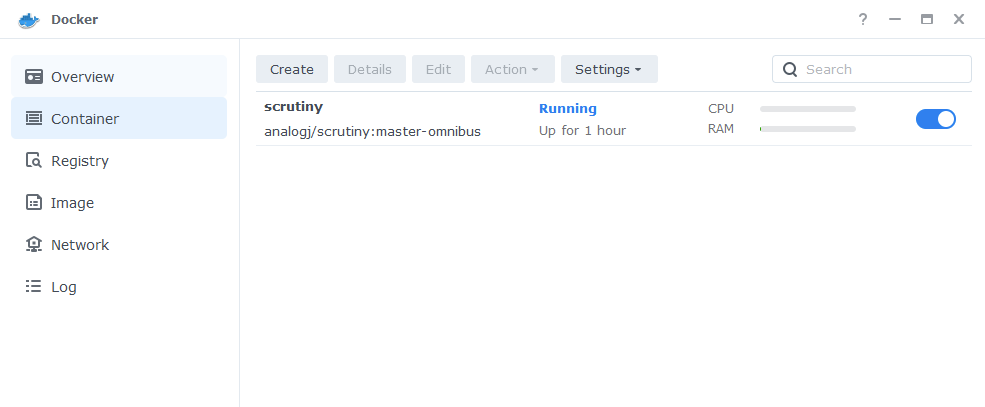
You should now be able to access the Scrutiny WebUI by going to your NAS IP followed by port 6090
e.g., 192.168.0.30:6090

Sometimes it can take a few minutes before all your drives appear, as Scrutiny needs to obtain their information so don’t panic if it’s initially empty. You can now adjust settings for the UI and Notifications in the WebUI.
Looking for some help, join our Discord community
If you are struggling with any steps in the guides or looking to branch out into other containers join our Discord community!
Buy me a beverage!
If you have found my site useful please consider pinging me a tip as it helps cover the cost of running things or just lets me stay hydrated. Plus 10% goes to the devs of the apps I do guides for every year.
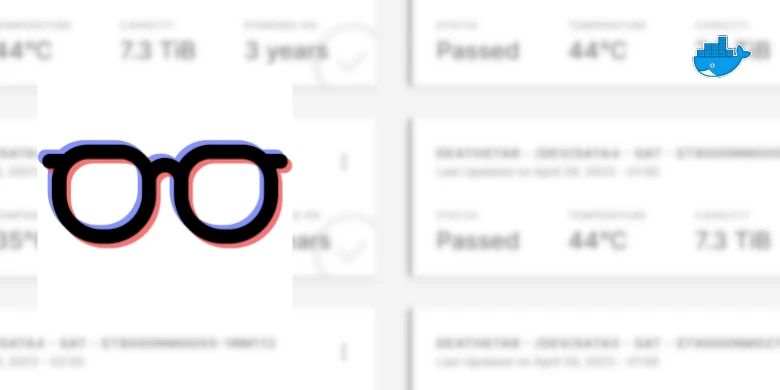



This works great for me. Thanks for nice work!!!
I think this line [“8086:8086” # influxDB admin] is not necessary, for this api is accessed only inside container. Mine works fine without this line.
And still I have a problem, which is after changing or adding disks, the /dev/sataX number X is changed for a certain disk, even if I didn’t change this disk. (Not always, but happens time to time.) Every time this happens, I have to delete all influxDB to not introduce wrong history data. Do you have any idea about this?
Hey, yeah I may just comment out the additional port so people could optionally activate it.
Do you mean if you remove drives 1 and 4 and put them back in the opposite bays, I hadn’t even considered that – Are you sure Scrutiny is not just picking up the correct info and assigning to the correct disk.. I suppose the only test would be to check the power on hours or something.
Hello,
one question:
How can i incorporate a DX517?
Thank you and have a nice day…
Hey, so the drives should show up using the same method, happy to have a look at the output of the command which lists the drives for you.
Drop it into my paste.drfrankenstein.co.uk and reply with the URL it gives you here.
Hi Dr. Frankenstein,
Really appreciate these tutorials!
Only issue I’m having is Scrutiny is not requesting a password to view the page. This wouldn’t be a problem at home but I do have it set up on an 1821+ in a school network and I’d rather not rely on obscurity to keep kids from trashing my SMART data tracking.
Any tips or ideas?
Thanks!
Looks like this has been requested –
https://github.com/AnalogJ/scrutiny/issues/34 might be worth bumping the option. The alternative is to use your firewall to block access to the port other than specific IPs?
use nginx
hi,
i follow the setup and check it again. the scrutiny Dashboard is still empty.
here is my setting
services:
scrutiny:
container_name: scrutiny
image: ghcr.io/analogj/scrutiny:master-omnibus
cap_add:
– SYS_RAWIO
– SYS_ADMIN
ports:
– “6090:8087” # webapp
– “8086:8086” # influxDB admin
volumes:
– /run/udev:/run/udev:ro
– /volume2/docker/scrutiny:/opt/scrutiny/config
– /volume2/docker/scrutiny/influxdb:/opt/scrutiny/influxdb
devices:
– /dev/sdb:/dev/sdb
– /dev/sdc:/dev/sdc
– /dev/sdd:/dev/sdd
– /dev/sde:/dev/sde
– /dev/sdf:/dev/sdf
– /dev/sdg:/dev/sdg
– /dev/sdh:/dev/sdh
environment:
– SCRUTINY_WEB_INFLUXDB_TOKEN=ANYLONGSTRING
– SCRUTINY_WEB_INFLUXDB_INIT_USERNAME=00000
– SCRUTINY_WEB_INFLUXDB_INIT_PASSWORD=00000
network_mode: synobridge
restart: unless-stopped
version: 1
host:
id: “”
devices:
– device: /dev/sdb
type: ‘sat’
– device: /dev/sdc
type: ‘sat’
– device: /dev/sdd
type: ‘sat’
– device: /dev/sde
type: ‘sat’
– device: /dev/sdf
type: ‘sat’
– device: /dev/sdg
type: ‘sat’
– device: /dev/sdh
type: ‘sat’
Hey thanks, the above looks perfect, and I assume when you checked the drive (devices) via SSH they appeared as /dev/sdb etc and not /sata1 etc.
Which model NAS are you using?
Do you see any errors in the logs at all. Feel free to dump them and upload to my paste.drfrankenstein.co.uk site and share the link here or via my HelpMe! page.
Also can I see the config file as well please.
i use DS3622xs+ (xpenology). i have upload the log to the site.
https://paste.drfrankenstein.co.uk/?1fe8f37c17d50cdc#Gx9vGGvrCYSWmyzHi4SSHvYXEc6pUZwb2Sum4iS2Y3Fi
This leaps out the log as being an issue as it appears about 200 times lol!
scrutiny api not ready
Are you seeing any files being created in the /docker/scrutiny folder as it looks like the database was never ready, and it has dropped back to using sql-lite. As you are using non Synology hardware it’s going to be hard to tell if this is just an issue container wise or your underlying hardware.
Have you ever found a solution to that problem? I’m also on Xpenology and scrutiny can’t find my drives.
Good day, thank you for your effort to help us! I followed your instructions but I have 2 problems, when I create a Docker Bridge Network, I’m asked to enter an IP range, otherwise I can’t add it without it, Subnet OK, Gateway OK.
The second error is when I’m in SSH and use the last command, this appears
(no such file or directory).
I don’t know how I can send you a printscreen so you can see better what I’m talking about.
I apologize because I don’t speak English so maybe I don’t explain well, I use a translator 🙂
I am using this model Synology Nas918+ DSM 7.2.1-69057 Update 1
Thank you very much in advance!
Hey
It looks like you missed the message at the top of the guide. You need to follow the updated version of the guide here 🙂
https://drfrankenstein.co.uk/2023/05/29/scrutiny-in-container-manager-on-a-synology-nas/
You’re right, I missed that, now I did everything from the beginning and now everything works for me 🙂
Thank you very much!!!